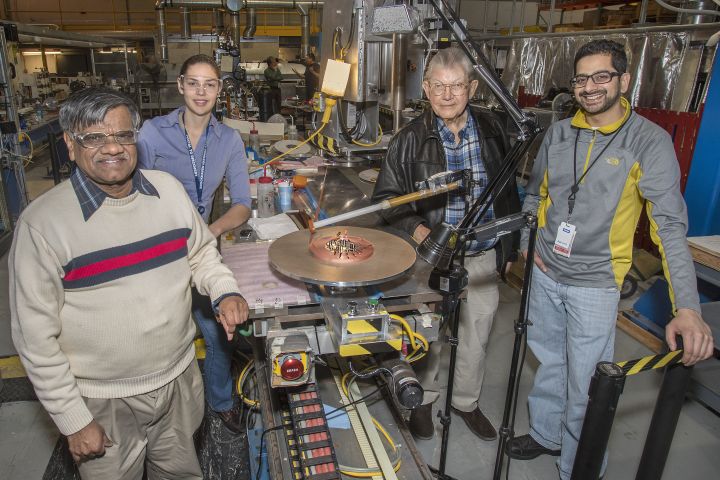HTS Magnet Program at BNL (Demonstrations, Presentations, Publications)
High Temperature Superconductors (HTS) have the potential to revolutionize the field of superconducting magnets for particle accelerators, energy storage systems, medical and space applications, among others. This is because of the fact that as compared to the conventional Low Temperature Superconductors (LTS), the critical current density (Jc) of HTS falls slowly both:
- as a function of increasing field, and
- as a function of increasing temperature
These unique properties can be utilized to design and build:
- HTS magnets that produce very high fields (20 – 50 T)
- HTS magnets that operate at elevated temperatures (20 – 77 K)
This is a significant step forward over the convention LTS magnets which generally operate at a temperature of ~4 K and with field usually limited to ~16 T. Moreover, the operating temperature of HTS magnets need not be controlled precisely (temperature control can be relaxed to a few degree rather than a few tenths of a degree in conventional LTS), simplifying the cryogenic system. In addition, HTS coils can tolerate a large temperature rise (up to several degrees) without significant loss in performance and therefore can tolerate a large energy deposition from decay particles, etc.
The Superconducting Magnet Division (SMD) at the Brookhaven National Laboratory (BNL) has been active in developing HTS technology for over a decade. It is not only the first major international laboratory to initiate HTS magnet R&D program but also currently poses an unmatched experience in designing, building and testing HTS coils and magnets. In addition, it has unique facilities for testing high current HTS wires, tapes and cables in applied fields. A large number of coils with essentially all types of HTS available in reasonable lengths have been successfully built and tested. This includes solenoid and pancake coils made with Bi2212 Rutherford cable, Bi2212 tape, Bi2223 tape, ReBCO tapes and MgB2 tape tested in a variety of magnet structures. The size of BNL HTS program can be measured from the fact that so far over 50 km length of conductor has been obtained (normalized to 4 mm tape equivalent). Several HTS magnet R&D programs for a variety of applications have been supported by a number of funding agencies over two decades.
BNL has built over 50 coils with the first generation (1G) HTS and over 100 coils with the second generation (2G) HTS for a wide range of applications. In some cases the applications are either high field or high temperature and in other cases in between – namely medium field (2-3 T) and medium temperature (20-60 K). These programs help one another in developing a wider understanding of the field and allow sharing of resources to carry out cost-effective R&D to overcome several technical challenges.

Following is the list of major HTS magnet R&D programs that have been funded by various agencies during the last decade:
- High field hybrid magnet R&D under US Magnet Development Program (record hybrid field of 12.3 T)
- 25 T HTS solenoid R&D for Axion search funded by Institute of Basic Energy Sciences, Korea
- High Energy Density Superconducting Magnetic Energy Storage System (SMES) made entirely of second generation HTS. BNL, in partnership with ABB, University of Houston, and SuperPower, was involved in developing this technology.
- High field (20+ T) HTS solenoid was carried out under a series of SBIRs with Particle Beam Lasers (PBL), Inc. This was considered to be an important first step towards developing technology of very high field solenoids (~40 T) for the ionization cooling in the proposed Muon Accelerator Program (MAP).
- HTS quadrupole with the second generation (2G) superconductor for Facility for Rare Isotope Beams (FRIB) which will be situated at Michigan State University. (Publications, Presentations).
- HTS solenoid for Energy Recovery Linac (ERL) at BNL.

HTS SMES Inner Coil
In addition, the following HTS R&D programs were completed over a decade ago:
- HTS quadrupole for Rare Isotope Accelerator (RIA) with the first generation (1G) Superconductor. (Publications, Presentations).
- Common coil R&D dipoles with Bi2212 Rutherford cable (Paper, Presentation).
- HTS solenoid for superconducting electron gun.
Furthermore, BNL has designed, built and tested a flexible cryogen free HTS magnet where the cooling is entirely obtained with cryo-coolers.
For more information on HTS R&D at BNL, please click on the following links:
HTS Publications, HTS Presentations, HTS Notes, BNL Bulletin, BNL Newsroom




